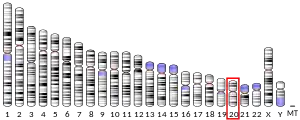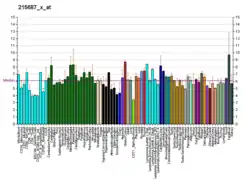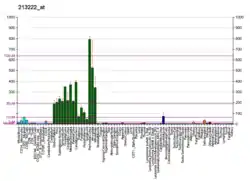PLCB1
1-Phosphatidylinositol-4,5-bisphosphate phospholipase beta-1 is an enzyme that in humans is encoded by the PLCB1 gene.[5][6][7]
Function
The protein encoded by this gene catalyzes the formation of inositol 1,4,5-trisphosphate and diacylglycerol from phosphatidylinositol 4,5-bisphosphate. This reaction uses calcium as a cofactor and plays an important role in the intracellular transduction of many extracellular signals. This gene is activated by two G-protein alpha subunits, alpha-q and alpha-11. Two transcript variants encoding different isoforms have been found for this gene.[7]
Pathology
Homozygous PLCB1 deletion is associated with malignant migrating partial seizures in infancy.[9]
References
- GRCh38: Ensembl release 89: ENSG00000182621 - Ensembl, May 2017
- GRCm38: Ensembl release 89: ENSMUSG00000051177 - Ensembl, May 2017
- "Human PubMed Reference:". National Center for Biotechnology Information, U.S. National Library of Medicine.
- "Mouse PubMed Reference:". National Center for Biotechnology Information, U.S. National Library of Medicine.
- Peruzzi D, Calabrese G, Faenza I, Manzoli L, Matteucci A, Gianfrancesco F, Billi AM, Stuppia L, Palka G, Cocco L (Jun 2000). "Identification and chromosomal localisation by fluorescence in situ hybridisation of human gene of phosphoinositide-specific phospholipase C beta(1)". Biochim. Biophys. Acta. 1484 (2–3): 175–82. doi:10.1016/s1388-1981(00)00012-3. PMID 10760467.
- Caricasole A, Sala C, Roncarati R, Formenti E, Terstappen GC (Jan 2001). "Cloning and characterization of the human phosphoinositide-specific phospholipase C-beta 1 (PLC beta 1)". Biochim. Biophys. Acta. 1517 (1): 63–72. doi:10.1016/S0167-4781(00)00260-8. PMID 11118617.
- "Entrez Gene: PLCB1 phospholipase C, beta 1 (phosphoinositide-specific)".
- Runnels LW, Yue L, Clapham DE (May 2002). "The TRPM7 channel is inactivated by PIP(2) hydrolysis". Nat. Cell Biol. 4 (5): 329–36. doi:10.1038/ncb781. PMID 11941371. S2CID 21592843.
- Poduri A, Chopra SS, Neilan EG, Elhosary PC, Kurian MA, Meyer E, Barry BJ, Khwaja OS, Salih MA, Stödberg T, Scheffer IE, Maher ER, Sahin M, Wu BL, Berry GT, Walsh CA, Picker J, Kothare SV (2012). "Homozygous PLCB1 deletion associated with malignant migrating partial seizures in infancy". Epilepsia. 53 (8): e146–50. doi:10.1111/j.1528-1167.2012.03538.x. PMC 3851296. PMID 22690784.
Further reading
- Nakajima D, Okazaki N, Yamakawa H, Kikuno R, Ohara O, Nagase T (2002). "Construction of expression-ready cDNA clones for KIAA genes: manual curation of 330 KIAA cDNA clones". DNA Res. 9 (3): 99–106. doi:10.1093/dnares/9.3.99. PMID 12168954.
- Martelli AM, Fiume R, Faenza I, Tabellini G, Evangelista C, Bortul R, Follo MY, Falà F, Cocco L (2005). "Nuclear phosphoinositide specific phospholipase C (PI-PLC)-beta 1: a central intermediary in nuclear lipid-dependent signal transduction". Histol. Histopathol. 20 (4): 1251–60. PMID 16136505.
- Cocco L, Follo MY, Faenza I, Bavelloni A, Billi AM, Martelli AM, Manzoli L (2007). "Nuclear inositide signaling: an appraisal of phospholipase C beta 1 behavior in myelodysplastic and leukemia cells". Adv. Enzyme Regul. 47: 2–9. doi:10.1016/j.advenzreg.2006.12.003. PMID 17335878.
- Cefai D, Debre P, Kaczorek M, Idziorek T, Autran B, Bismuth G (1990). "Human immunodeficiency virus-1 glycoproteins gp120 and gp160 specifically inhibit the CD3/T cell-antigen receptor phosphoinositide transduction pathway". J. Clin. Invest. 86 (6): 2117–24. doi:10.1172/JCI114950. PMC 329852. PMID 1979339.
- Zauli G, Previati M, Caramelli E, Bassini A, Falcieri E, Gibellini D, Bertolaso L, Bosco D, Robuffo I, Capitani S (1995). "Exogenous human immunodeficiency virus type-1 Tat protein selectively stimulates a phosphatidylinositol-specific phospholipase C nuclear pathway in the Jurkat T cell line". Eur. J. Immunol. 25 (9): 2695–700. doi:10.1002/eji.1830250944. PMID 7589147. S2CID 20562627.
- Hwang SC, Park KH, Ha MJ, Noh IS, Park TB, Lee YH (1996). "Distribution of phospholipase C isozymes in normal human lung tissue and their immunohistochemical localization". J. Korean Med. Sci. 11 (4): 305–13. doi:10.3346/jkms.1996.11.4.305. PMC 3054083. PMID 8878798.
- Chen P, Mayne M, Power C, Nath A (1997). "The Tat protein of HIV-1 induces tumor necrosis factor-alpha production. Implications for HIV-1-associated neurological diseases". J. Biol. Chem. 272 (36): 22385–8. doi:10.1074/jbc.272.36.22385. PMID 9278385.
- Nagase T, Ishikawa K, Miyajima N, Tanaka A, Kotani H, Nomura N, Ohara O (1998). "Prediction of the coding sequences of unidentified human genes. IX. The complete sequences of 100 new cDNA clones from brain which can code for large proteins in vitro". DNA Res. 5 (1): 31–9. doi:10.1093/dnares/5.1.31. PMID 9628581.
- Snow BE, Hall RA, Krumins AM, Brothers GM, Bouchard D, Brothers CA, Chung S, Mangion J, Gilman AG, Lefkowitz RJ, Siderovski DP (1998). "GTPase activating specificity of RGS12 and binding specificity of an alternatively spliced PDZ (PSD-95/Dlg/ZO-1) domain". J. Biol. Chem. 273 (28): 17749–55. doi:10.1074/jbc.273.28.17749. PMID 9651375.
- Mayne M, Bratanich AC, Chen P, Rana F, Nath A, Power C (1998). "HIV-1 tat molecular diversity and induction of TNF-alpha: implications for HIV-induced neurological disease". Neuroimmunomodulation. 5 (3–4): 184–92. doi:10.1159/000026336. PMID 9730685. S2CID 19529677.
- Haughey NJ, Holden CP, Nath A, Geiger JD (1999). "Involvement of inositol 1,4,5-trisphosphate-regulated stores of intracellular calcium in calcium dysregulation and neuron cell death caused by HIV-1 protein tat". J. Neurochem. 73 (4): 1363–74. doi:10.1046/j.1471-4159.1999.0731363.x. PMID 10501179. S2CID 25410140.
- Mayne M, Holden CP, Nath A, Geiger JD (2000). "Release of calcium from inositol 1,4,5-trisphosphate receptor-regulated stores by HIV-1 Tat regulates TNF-alpha production in human macrophages". J. Immunol. 164 (12): 6538–42. doi:10.4049/jimmunol.164.12.6538. PMID 10843712.
- Tang Y, Tang J, Chen Z, Trost C, Flockerzi V, Li M, Ramesh V, Zhu MX (2000). "Association of mammalian trp4 and phospholipase C isozymes with a PDZ domain-containing protein, NHERF". J. Biol. Chem. 275 (48): 37559–64. doi:10.1074/jbc.M006635200. PMID 10980202.
- Dowal L, Elliott J, Popov S, Wilkie TM, Scarlata S (2001). "Determination of the contact energies between a regulator of G protein signaling and G protein subunits and phospholipase C beta 1". Biochemistry. 40 (2): 414–21. doi:10.1021/bi001923+. PMID 11148035.
- Xu A, Wang Y, Xu LY, Gilmour RS (2001). "Protein kinase C alpha -mediated negative feedback regulation is responsible for the termination of insulin-like growth factor I-induced activation of nuclear phospholipase C beta1 in Swiss 3T3 cells". J. Biol. Chem. 276 (18): 14980–6. doi:10.1074/jbc.M009144200. PMID 11278470.
- Xu A, Suh PG, Marmy-Conus N, Pearson RB, Seok OY, Cocco L, Gilmour RS (2001). "Phosphorylation of nuclear phospholipase C beta1 by extracellular signal-regulated kinase mediates the mitogenic action of insulin-like growth factor I". Mol. Cell. Biol. 21 (9): 2981–90. doi:10.1128/MCB.21.9.2981-2990.2001. PMC 86927. PMID 11287604.
- Vitale M, Matteucci A, Manzoli L, Rodella L, Mariani AR, Zauli G, Falconi M, Billi AM, Martelli AM, Gilmour RS, Cocco L (2001). "Interleukin 2 activates nuclear phospholipase Cbeta by mitogen-activated protein kinase-dependent phosphorylation in human natural killer cells". FASEB J. 15 (10): 1789–91. doi:10.1096/fj.01-0008fje. PMID 11481231. S2CID 13373496.
- Singer AU, Waldo GL, Harden TK, Sondek J (2002). "A unique fold of phospholipase C-beta mediates dimerization and interaction with G alpha q". Nat. Struct. Biol. 9 (1): 32–6. doi:10.1038/nsb731. PMID 11753430. S2CID 13301839.
This article is issued from Wikipedia. The text is licensed under Creative Commons - Attribution - Sharealike. Additional terms may apply for the media files.






